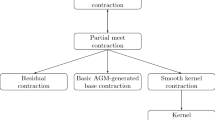Abstract
Blockage contraction is an operation of belief contraction that acts directly on the outcome set, i.e. the set of logically closed subsets of the original belief set K that are potential contraction outcomes. Blocking is represented by a binary relation on the outcome set. If a potential outcome X blocks another potential outcome Y, and X does not imply the sentence p to be contracted, then Y ≠ K ÷ p. The contraction outcome K ÷ p is equal to the (unique) inclusion-maximal unblocked element of the outcome set that does not imply p. Conditions on the blocking relation are specified that ensure the existence of such a unique inclusion-maximal set for all sentences p. Blockage contraction is axiomatically characterized and its relations to AGM-style operations are investigated. In a finite-based framework, every transitively relational partial meet contraction is also a blockage contraction.
Similar content being viewed by others
References
Alchourrón, C., Gärdenfors, P., & Makinson, D. (1985). On the logic of theory change: Partial meet contraction and revision functions. Journal of Symbolic Logic, 50, 510–530.
Alchourrón, C., & Makinson, D. (1981). Hierarchies of regulation and their logic. In R. Hilpinen (Ed.), New studies in deontic logic (pp. 125–148). Dordrecht: Reidel.
Alchourrón, C., & Makinson, D. (1982). On the logic of theory change: Contraction functions and their associated revision functions. Theoria, 48, 14–37.
Cayrol, C., Dupin de Saint-Cyr, F., & Lagasquie-Schiex, M.-C. (2010). Change in abstract argumentation frameworks: Adding an argument. Journal of Artificial Intelligence Research, 38, 49–84.
Dung, P. M. (1995). On the acceptability of arguments and its fundamental role in nonmonotonic reasoning, logic programming and n-person games. Artificial Intelligence, 77, 321–357.
Falappa, M. A., García, A. J., Kern-Isberner, G., & Simari, G. R. (2011). On the evolving relation between belief revision and argumentation. Knowledge Engineering Review, 26, 35–43.
Fermé, E., & Hansson, S. O. (2011). AGM 25 years. Twenty-five years of research in belief change. Journal of Philosophical Logic, 40, 295–331.
Fermé, E., Saez, K., & Sanz, P. (2003). Multiple kernel contraction. Studia Logica, 73, 183–195.
Fuhrmann, A., & Hansson, S. O. (1994). A survey of multiple contractions. Journal of Logic, Language, and Information, 3, 39–76.
Gärdenfors, P. (1982). Rules for rational changes of belief. In T. Pauli (Ed.), Philosophical essays dedicated to Lennart Åqvist on his fiftieth birthday. Philosophical studies (Vol. 34, pp. 88–101). Published by the Philosophical Society and the Department of Philosophy. Uppsala: University of Uppsala.
Glaister, S. M. (2000). Recovery recovered. Journal of Philosophical Logic, 29, 171–206.
Grove, A. (1988). Two modellings for theory change. Journal of Philosophical Logic, 17, 157–170.
Hansson, S. O. (1991). Belief contraction without recovery. Studia Logica, 50, 251–260.
Hansson, S. O. (1992). Similarity semantics and minimal changes of belief. Erkenntnis, 37, 401–429.
Hansson, S. O. (1992). A dyadic representation of belief. In P. Gärdenfors (Ed.), Belief revision (pp. 89–121). Cambridge: Cambridge University Press.
Hansson, S. O. (1993). Theory contraction and base contraction unified. Journal of Symbolic Logic, 58, 602–625.
Hansson, S. O. (1994). Kernel contraction. Journal of Symbolic Logic, 59, 845–859.
Hansson, S. O. (1999). A textbook of belief dynamics. Theory change and database updating. Dordrecht: Kluwer Academic.
Hansson, S. O. (2008). Specified meet contraction. Erkenntnis, 69, 31–54.
Levi, I. (1977). Subjunctives, dispositions and chances. Synthese, 34, 423–455.
Levi, I. (1991). The fixation of belief and its undoing. Cambridge, MA.: Cambridge University Press.
Makinson, D. (1997). On the force of some apparent counterexamples to recovery. In E. Garzón Valdéz, et al. (Eds.), Normative systems in legal and moral theory: Festschrift for Carlos Alchourrón and Eugenio Bulygin (pp. 475–481). Berlin: Duncker & Humblot.
Meyer, T., Heidema, J., Labuschagne, W., & Leenen, L., (2002). Systematic withdrawal. Journal of Philosophical Logic, 31, 415–443.
Rott, H., & Pagnucco, M. (1999). Severe withdrawal (and recovery). Journal of Philosophical Logic, 28, 501–547.
Sandqvist, T. (2000). On why the best should always meet. Economics and Philosophy, 16, 287–313.
Author information
Authors and Affiliations
Corresponding author
Rights and permissions
About this article
Cite this article
Hansson, S.O. Blockage Contraction. J Philos Logic 42, 415–442 (2013). https://doi.org/10.1007/s10992-012-9231-9
Received:
Accepted:
Published:
Issue Date:
DOI: https://doi.org/10.1007/s10992-012-9231-9



